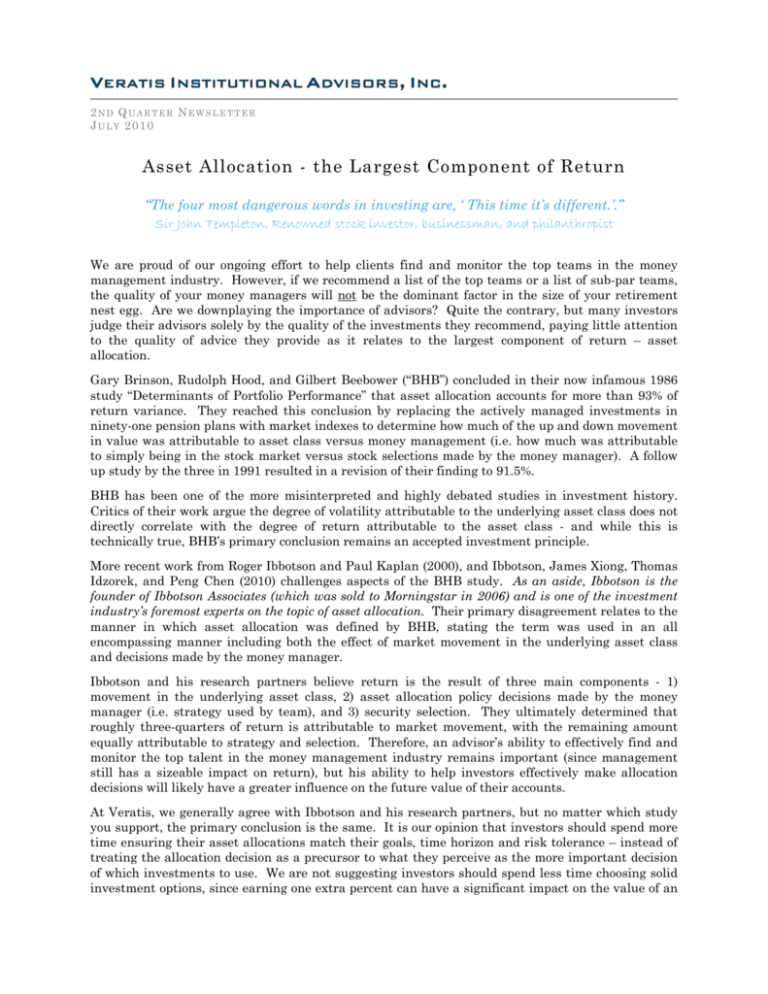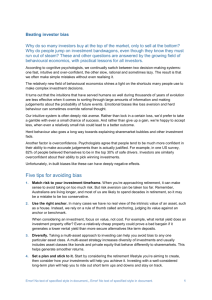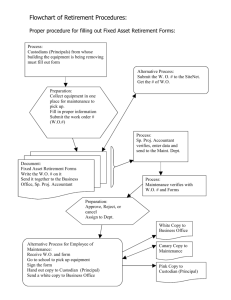
VERATIS INSTITUTIONAL ADVISORS, INC.
2ND QUARTER NEWSLETTER
JULY 2010
Asset Allocation - the Largest Component of Return
“The four most dangerous words in investing are, ‘ This time it’s different.’.”
Sir John Templeton, Renowned stock investor, businessman, and philanthropist
We are proud of our ongoing effort to help clients find and monitor the top teams in the money
management industry. However, if we recommend a list of the top teams or a list of sub-par teams,
the quality of your money managers will not be the dominant factor in the size of your retirement
nest egg. Are we downplaying the importance of advisors? Quite the contrary, but many investors
judge their advisors solely by the quality of the investments they recommend, paying little attention
to the quality of advice they provide as it relates to the largest component of return – asset
allocation.
Gary Brinson, Rudolph Hood, and Gilbert Beebower (“BHB”) concluded in their now infamous 1986
study “Determinants of Portfolio Performance” that asset allocation accounts for more than 93% of
return variance. They reached this conclusion by replacing the actively managed investments in
ninety-one pension plans with market indexes to determine how much of the up and down movement
in value was attributable to asset class versus money management (i.e. how much was attributable
to simply being in the stock market versus stock selections made by the money manager). A follow
up study by the three in 1991 resulted in a revision of their finding to 91.5%.
BHB has been one of the more misinterpreted and highly debated studies in investment history.
Critics of their work argue the degree of volatility attributable to the underlying asset class does not
directly correlate with the degree of return attributable to the asset class - and while this is
technically true, BHB’s primary conclusion remains an accepted investment principle.
More recent work from Roger Ibbotson and Paul Kaplan (2000), and Ibbotson, James Xiong, Thomas
Idzorek, and Peng Chen (2010) challenges aspects of the BHB study. As an aside, Ibbotson is the
founder of Ibbotson Associates (which was sold to Morningstar in 2006) and is one of the investment
industry’s foremost experts on the topic of asset allocation. Their primary disagreement relates to the
manner in which asset allocation was defined by BHB, stating the term was used in an all
encompassing manner including both the effect of market movement in the underlying asset class
and decisions made by the money manager.
Ibbotson and his research partners believe return is the result of three main components - 1)
movement in the underlying asset class, 2) asset allocation policy decisions made by the money
manager (i.e. strategy used by team), and 3) security selection. They ultimately determined that
roughly three-quarters of return is attributable to market movement, with the remaining amount
equally attributable to strategy and selection. Therefore, an advisor’s ability to effectively find and
monitor the top talent in the money management industry remains important (since management
still has a sizeable impact on return), but his ability to help investors effectively make allocation
decisions will likely have a greater influence on the future value of their accounts.
At Veratis, we generally agree with Ibbotson and his research partners, but no matter which study
you support, the primary conclusion is the same. It is our opinion that investors should spend more
time ensuring their asset allocations match their goals, time horizon and risk tolerance – instead of
treating the allocation decision as a precursor to what they perceive as the more important decision
of which investments to use. We are not suggesting investors should spend less time choosing solid
investment options, since earning one extra percent can have a significant impact on the value of an
account at retirement. We are simply stating that aside from contribution, no factor will have more
impact on the size of retirement nest eggs than the percentage investors allocate to stocks, bonds and
stable value investments.
Are you comfortable with your decision?
Due to recent market volatility and performance, investors are questioning their allocation decisions.
This is normal in such market environments, but it is important to reconsider the factors that should
influence your decision before making a change. In addition, it is important to be cognizant of the
impact of emotion. Emotion often causes investors to make ill-timed allocation changes after market
downturns - a damaging event in most cases.
Allocation decisions should be based on the following factors:
1. Goals – The typical tradeoff when investing is between growth and protection. In other
words, there is a spectrum ranging from portfolios designed to maximize growth with little
protection to those designed to maximize protection with little growth. Of course, there are many
levels in-between, and you must determine the appropriate balance of growth and protection when
making the allocation decision.
2. Time horizon – Time horizon is the length of time between today and the day you will start
withdrawing money from your retirement account. For most investors, withdrawals begin at
retirement but that is not always the case. As an investor accumulates wealth and approaches his or
her withdrawal date, it is natural and prudent for the investor’s goals to change. The portfolio
design should shift to protect the assets the investor has worked to accumulate. When you are
young, taking risk to achieve growth is reasonable, but losing 40% in the stock market the year
before you begin withdrawals is not.
3. Risk tolerance – An investor’s appetite for risk often correlates with market performance –
primarily due to emotion. It is important for you to think ahead with an unemotional, long-term
view and choose a portfolio design that matches your goals and tolerance for volatility.
4. Financial position – Those who are behind in terms of the amount they have saved for
retirement need the assistance of growth, but they must be careful not to invest too aggressively for
their time horizon and risk tolerance. Conversely, the select few who have enough saved for
retirement should focus on protecting their account, not taking unnecessary risk.
5. Other retirement accounts and sources of income – When making decisions for this
retirement account, it is important to take into consideration the investment decisions you have
made in other accounts to ensure the combined accounts meet your objectives. It is also important to
factor in other sources of retirement income when determining how much growth (risk) is needed.
Transitioning your account
The initial allocation decision is only the first step. On an ongoing basis, it is important to make
sure your allocation remains appropriate given the decision factors listed. The factor that creates
the most need for allocation adjustment is time horizon. As you approach your withdrawal date, the
window of time for recovering losses narrows, therefore it is prudent to reduce risk. In general, there
are three phases of the retirement journey - accumulation, transition and withdrawal. In the
diagram below, we include some common age ranges for the three phases, but it is important to keep
in mind that the path to retirement can be quite different for investors based on various goals and
financial positions.
Accumulation
Age 21+
Transition
45 - 55
Withdrawal
62 - 67
85+
Page 2
There are several methods used by investors to transition their allocation as they approach
retirement. The difference in these approaches primarily relates to the timing, number and severity
of adjustments. In recent years, as the markets have become increasingly volatile, a slower, more
gradual reduction of risk has become popular. By making smaller adjustments, an investor reduces
the impact of poorly timed decisions (e.g. selling 20% of his stock allocation before a period of strong
market performance, or staying aggressive too long and experiencing a downturn close to the
withdrawal date).
The investment industry refers to these gradual risk reduction plans as “glide paths”, equating the
slow reduction in risk to an airplane’s preparation for landing. The industry has taken the concept a
step further by designing mutual funds that follow these glide paths, automatically adjusting an
investor’s allocation as they approach a predetermined target date. The idea is a solid one, but there
are a few caveats to target date funds (i.e. they typically do not take into account the investor’s risk
preference and are often built using funds from the sponsoring fund family). Another caveat relates
to the duration of the transition period. In order to facilitate a gradual transition, the process of
selling stocks often starts earlier than the diagram on the previous page and conventional wisdom
suggests, but this should not take away from long-term accumulation if the glide path is designed
correctly. For illustration purposes, a sample glide path is shown below.
100%
Allocation %
80%
60%
Stock
Bond
Stable Value
40%
20%
0%
45
40
35
30
25
20
15
10
5
0
Years Until Withdraw al
Conclusion
At Veratis, we have worked passionately over the years to ensure the plan participants we serve
make sound asset allocation decisions. However, the two major downturns of the past decade and
feedback from participants suggests to us that additional assistance would be appreciated in this
area. For this reason, we have spent the past two years developing new ways to assist participants
with allocation choices, and we are pleased with the results. We have designed a new tool to help
with the “right now” allocation decision and have developed a gradual transition program that takes
into account both time horizon and risk tolerance.
Please remember that as your plan advisor, we are here for you, and our assistance extends beyond
identifying and monitoring the top teams in the money management industry. Be assured that our
pursuit of the top managers is as rigorous as ever, but we understand the primary driver of return is
allocation, and helping you make sound decisions remains a top priority – especially since we believe
increased volatility is here to stay. If you would like to review your current asset allocation or plans
for transition, please do not hesitate to give us a call or schedule a time to meet with us during our
next on-site visit.
Page 3
Market Comments
A great battle is occurring in the global economy between the cyclical recovery and the opposing
structural headwinds - allow us to explain. During a recovery, the economy typically enjoys positive
momentum as consumers, business owners and investors regain confidence. In addition, it is
common for global governments and central banks to provide stimulus to help facilitate the
bottoming process, which also results in positive momentum on the recovery side of the cycle.
It is not uncommon for recoveries to encounter structural headwinds, and typically the largest of
these is unemployment. But this time unemployment has structural companions (e.g. global debt at
the consumer and government levels, consumers who have learned their spending lessons, and
continued financial downsizing), and they are proving to be a sizeable hurdle for the recovery. The
fact is that the problems we are dealing with were created over several decades and the recovery is
unlikely to occur overnight. In addition, the political banter of an election year and the seemingly
endless stream of emotion causing news are only increasing uncertainty - and thus volatility.
We remain confident in the resilience of the American economy, and the global economy in general,
but events like the debt crisis in Europe will continue to challenge the resolve of investors and
money mangers. We have been prepared for a two step forward, one step back recovery, which the
consensus of our most respected money managers continues to support. Due to the uncertainty of
such markets, it is important that you ensure the asset allocation you have chosen matches the
decision factors outlined in this newsletter.
Sources:
Brinson, Gary P., L. Randolph Hood, and Gilbert L. Beebower. 1986. “Determinants of Portfolio Performance.” Financial Analysts
Journal, vol. 42, no. 4 (July/August):39-40.
Ibbotson, Roger G., and Paul D. Kaplan. 2000. “Does Asset Allocation Policy Explain 40, 90, or 100 Percent of Performance?.”
Financial Analysts Journal, vol. 56, no. 1 (January/February):10-11.
Ibbbotson, Roger G. 2010. “The Importance of Asset Allocation.” Financial Analysts Journal, vol. 66, no. 2 (March/April).
Xiong, James, Roger Ibbotson, Thomas Idsorek, and Peng Chen. 2010. “The Equal Importance of Asset Allocation and Active
Management.” Financial Analysts Journal, vol. 66, no. 2 (March/April).
Huebscher, Robert. 2010. “Asset Allocation Matters, But Not as Much as You Think.” Advisor Perspectives, (June 15).
Disclaimers: While Veratis Institutional Advisors, Inc. uses reasonable efforts to obtain information from reliable sources, Veratis makes no representations or warranties as to
the accuracy, reliability or completeness of information obtained from third party sources presented herein. Any forward looking statements or forecasts are based on
assumptions and actual results are expected to vary from any such statements or forecasts. No reliance should be placed on any such statements or forecasts when making
any investment decision. The views expressed herein reflect information as of the publication date only and may change at any time without notice. The information provided is
confidential and shall not be copied or distributed without the express written approval of Veratis Institutional Advisor, Inc. No guarantee of investment performance is being
provided and no inference to the contrary shall be made. Copyright © 2010 Veratis Institutional Advisors, Inc. All rights reserved.
Page 4








